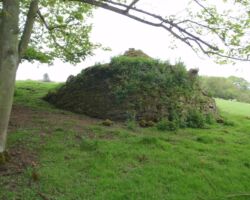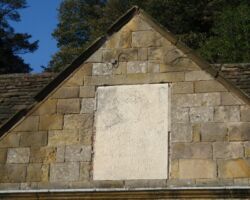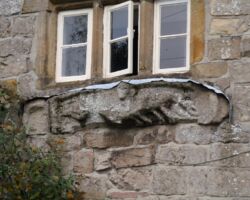Hopton was listed as Optune in Domesday and Hopton in 1246 in The Registrum Antiquissimum of the Cathedral Church of Lincoln.
It is a small village with evidence that it dates back to possibly 200,000 years ago by the discovery of a Middle Paleolithic Acheulean hand axe nearby.
The village had a long association with the Gell family, who have had assets in the Hopton since 1327 and lived at Hopton Hall. Notable members include Sir John Gell who was a Parliamentarian in the English Civil War and Sir William Gell who was an archaeologist.
In 1870-72, John Marius Wilson’s Imperial Gazetteer of England and Wales described :
HOPTON, a township in Wirksworth parish, Derby; 2 miles W by S of Wirksworth. Acres, 643. Real property, £1, 545. Pop., 115. Houses, 20. Hopton Hall was the seat of Sir John Gell, who figured as a parliamentarian leader in the wars of Charles I. Good building limestone is extensively quarried, and was the material of Chatsworth House and Belvoir Castle. Lead ore also occurs. Roman relics, including an inscription and an urn, have been found. alms houses, with £22 a year, were founded, in 1719, by Sir Philip Gell.
Hopton Hall
From ‘The Derbyshire Country House’ –
“The Gell family are recorded as holding an estate at Hopton since at least 1327, and can be traced with varying degrees of certainty back to Robert Gyll, a juror at Wirksworth in 1209: his posterity grew rich on the proceeds of marketing lead. Ralph Gell, grandson of the Ralph recorded in 1327, who died in 1433, is designated in a charter as a tenant in chief at Hopton.”
Pevsner describes the hall as
an Elizabethan house with two gabled projections, redone in the c18, when the garden front received Venetian windows, the centre between the projections was filled in and crowned by an oversize heavy segmental pediment and the entrance side completely Georgianised by the Gells.”
John Gell was created a baronet in 1642 in recognition of his efforts on behalf of Cromwell, who is said to have ordered him to remove and take possession of the House of Commons mace, having declared it a ‘fool’s bauble’.
The Gells claimed a wholly fictional descent from a Roman soldier named Gellius. This came about in the late eighteenth century when Philip Gell claimed to have unearthed a Derbyshire ware Romano-British pot, filled with burnt bones and ashes. The covering had an inscription with the words:’IFC/GELL/PRAE III COH/VI BRIT LEG’ which translates as ‘Gellius Prefect of the Third Cohort of the V Legion in Britain’. He wrote, in early 1793, to inform Major Hayman Rooke, a local antiquarian from Mansfield, that his labourers had been planting saplings at Abbots’ Low (Ivet Low) to the North of Hopton and had uncovered a cremation urn. Gell promised to keep it intact and in situ until Rooke could make the journey to properly excavate and examine it. Rooke was interested and from his account in Archaeologia, he reported that a bulky pot ‘of coarse baked earth’ was located some eighteen inches under the old ground surface and beneath five feet of barrow material. It was covered by a large flat stone 2ft 6in long, 1ft 8in wide and 9in thick, described as of ‘softish yellow freestone, and much corroded.’
He felt that the name Gellius cut into the slab was remarkable considering that the present landowner had the surname Gell. ‘Could Mr Gell’s family’ he conjectured ‘be descended from this ancient Roman?’ The presence of this particular name sadly triggered no alarm bells, and Rooke was hoaxed. Later Samuel Carrington, friend of Thomas Bateman, wrote ‘a Gell had once transformed a Rooke into a Gull.’
Around 1800 Philip Gell was responsible for the construction of the Via Gellia road which linked his lead mines at Carsington with the Cromford Canal. A mill in the valley produced a woollen fabric called Viyella which was an adaptation of the road name.
Another John Gell was a long-serving admiral, celebrated for his capture in 1793 of a Spanish ship containing a cargo valued at £935,000. Sir William Gell was a classical archaeologist and a chamberlain to Princess Caroline (later the Queen Consort of George II). He testified in court on behalf of the princess when she was accused of having an affair during a visit to Italy, but hinted later that he might have lied to protect her. Philip Eyre Gell is best known for constructing a road to link his lead-mining interests at Wirksworth with a new smelter at Cromford. He christened the route Via Gellia on the grounds that his family was supposedly descended from the Romans.
Crinkle Crankle wall
Hopton Hall has an unusually shaped boundary wall which is often described as a ‘crinkle crankle’ wall. The wall is divided by a high square building which looks out of place. Reputedly this was built as a summerhouse with the instruction to build upwards until instructed to stop. Unfortunately whilst being built it is said that the owner of the hall at that time went on a business trip to London which lasted longer than expected and thus the building ended up higher than intended.
Reputedly this was built as a summerhouse with the instruction to build upwards until instructed to stop. Unfortunately whilst being built it is said that the owner of the hall at that time went on a business trip to London which lasted longer than expected and thus the building ended up higher than intended.
Crinkle crankle walls, also known in various parts of the country as crinkum crankum, serpentine walls, ribbon walls and wavy walls, are an unusual type of garden wall with curving lines following a serpentine path rather than a straight line.
There are several benefits to this type of wall.
Since they can be made just one brick thin the crinkle crankle wall economizes on bricks, despite its sinuous configuration. If a wall this thin were to be made in a straight line, without buttresses, it would easily topple over. The alternate convex and concave curves in the wall provide stability and help it to resist lateral forces.
Both crinkle and crankle are defined as something with bends and turns (Webster’s), but the term is also thought to come from Old English meaning zig-zag. The earliest reference to this meaning has been cited in 1598, but it was not until the 18th century that the term began to be applied to wavy walls. At that time these garden walls were usually aligned east-west, so that one side faced south to catch the warming sun and were historically used for growing fruit.
Some schools of thought attribute this type of construction to Dutch engineers who were draining the fens in the mid-1600s and called them ‘slange muur’ meaning snaking wall.
It would appear the highest number of such walls is to be found in Suffolk who at 50 examples have twice as many as the rest of the country combined and where crankle is said to be derived from the local dialect.
Hopton Hall ice house is a grade II listed building described in British Listed Buildings as –
Icehouse. Late C18. Gritstone. Circular icehouse with domed roof, short access
passage half way up. Overall depth 7.5 m. In poor state of repair with dome
exposed and passage partially collapsed.
Ice houses were buildings that were commonly used on large estates prior to the invention of the refrigerator to store ice throughout the year. Their construction varied, some being underground chambers but many were buildings with various types of insulation,, usually located close to natural sources of winter ice such as freshwater lakes.
During the winter, ice and snow would be taken into the ice house and packed with insulation, often straw or sawdust. It would remain frozen for many months, often until the following winter, and could be used as a source of ice during summer months. The main application of the ice was the storage of perishable foods, but it could also be used simply to cool drinks, or allow ice-cream and sorbet desserts to be prepared.
Hopton Toll Bar cottage

A plaque in the centre gable of this Grade II Listed building states –
This Hospital was begun (sic) 1719 by
Philip Gell
in his lifetime
and by him Endowd (sic) for the use of two
poor MEN and two poor WOMEN of
HOPTON and CARSON
Finished by his EXECUTORS
And inhabited Sept 1722
There is an unusual window sill on one building which looks like an old tympanum featuring George and the Dragon.
probably the village water supply










